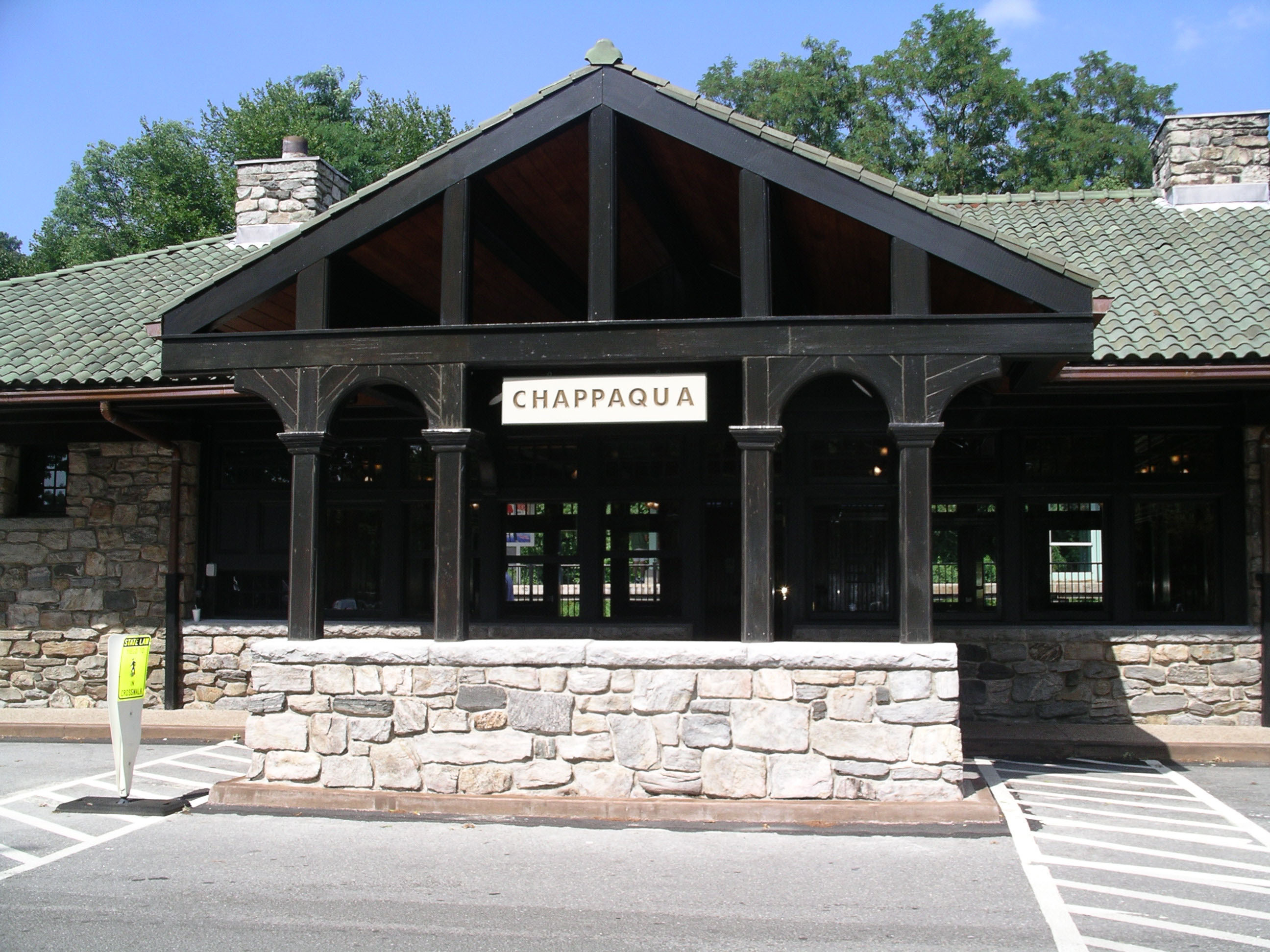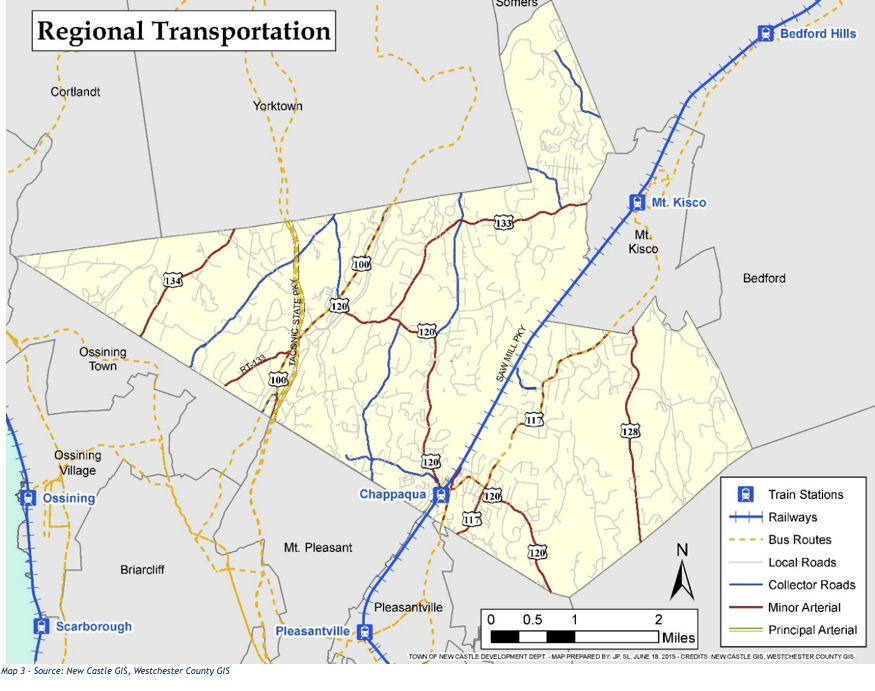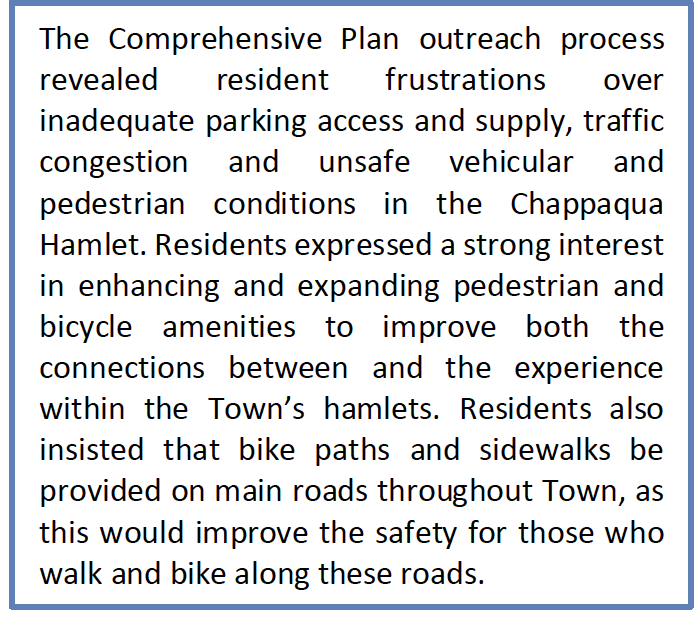Transportation Network
Livable Built Environment:
Transportation Network

New Castle’s livability is affected by the ease of movement around Town and between and within the hamlets. In New Castle, it is easy to travel north to south and vice versa; NYS Routes 134, 100, 117 and 128 and the County’s Pinesbridge and Seven Bridges Roads provide easy vehicular access between the Town’s northern- and southern-most boundaries, and into neighboring municipalities. Travelling from east to west is less simple; NYS Route 120, NYS Route 133 and Roaring Brook Road provide less efficient transit in an east-to-west direction between the hamlets. While east-to-west traffic flow is expected to remain limited primarily because of existing environmental and topographic conditions, this Plan establishes goals to enhance existing connections and establish alternative transportation linkages between the hamlets and major destinations within the Town and region.
As was the case in 1989, privately owned vehicles still provide the predominant method of transportation in New Castle today. As car companies introduce autonomous or “self-driving” cars into the automotive marketplace over the next few years, dependence on automobiles is unlikely to change since such vehicles might enable private travel by those who are unable to drive independently. Besides school bus service, there is currently inadequate public or alternative transportation network that provides linkages within the Town. In regards to public transportation and transportation linkages with municipalities in the surrounding region, both Millwood and Chappaqua are each served by a Westchester County Bee Line bus. Bus route #19 from Pleasantville through the Chappaqua hamlet and continues into the Village of Mount Kisco, while bus route #15 travels from Briarcliff and Mt. Pleasant through the hamlet of Millwood into the Town of Yorktown. Service can be infrequent and inconsistent, which can affect utilization.
Conversely, the Chappaqua Train Station, which provides access to Metro North’s Harlem Line and a fifty- minute average train ride to New York City, is highly utilized by Town residents and non-residents alike.


This is the only train station within the Town. As such it is worth noting that residents also use train stations located in Mount Kisco, Ossining and elsewhere, depending on the proximity of the train station to their place of residence. Every week day, the commuter parking lots abutting the train station in the Chappaqua hamlet, which provide over 1,300 parking spaces, fill to n ear capacity by early to mid-morning. During peak periods, queuing of cars affects the flow of traffic in and out of the train station and slows vehicular circulation throughout the hamlet. In addition, overflowing public parking lots, a lack of wayfinding signage and the design of Chappaqua’s circulation system can make it difficult for drivers, especially those unfamiliar with the Chappaqua hamlet, to park and shop.
The redevelopment of Chappaqua Crossing as a multi-use traditional neighborhood designed campus currently includes the provision of a jitney connection to the Chappaqua Hamlet and the Metro North railroad station. Expanding alternative transportation connections, such as the jitney, between the Millwood and Chappaqua hamlets and creating smoother circulation within downtown Chappaqua (particularly in regards to traffic flow and parking during weekends and peak commute times) would greatly improve mobility for New Castle residents. While it is likely that the primary method of transportation will remain the privately owned car, Town residents have expressed desire for community and public transportation as well as solutions for a strained parking supply. This Plan promotes development that acknowledges growing parking demand, seeks to increase reliance on the use of alternative transportation and propagates the policies put forth in the TDP in support of the expansion of sidewalks, trailways and bike lanes. Establishing visual circulation aids, such as wayfinding and other signage, will also help facilitate more cohesive connections between the hamlets and other prominent destinations, both within the Town and the region.